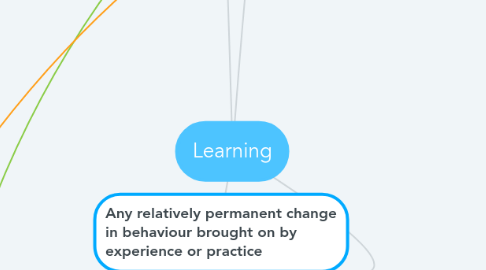
1. Learning Memorization
1.1. Types of Memory
1.1.1. Sensory Memory
1.1.1.1. Precursor to short-term memory that allows you to process and recall the learning you take in
1.1.2. Short Term Memory
1.1.2.1. Information learners are currently aware or thinking about
1.1.3. Working Memory
1.1.3.1. Overload Signs: incomplete recall etc
1.1.3.2. The ability to hold information in mind for a brief time and work with it
1.1.4. Long Term Memory
1.1.4.1. Unlimited and permanent storage of information
1.1.4.1.1. Explicit Memory
1.1.4.1.2. Implicit Memory
1.2. Information Processing Model
1.2.1. Dual Coding Theory
1.2.1.1. Explains human behaviour and experience in terms of dynamic processes that operate on verbal and non-verbal networks
1.2.1.1.1. Spiritual Contiguity or Split Attention Principle
1.2.1.1.2. Redundancy Principle
1.2.1.1.3. Modality or Multi Media Principle
1.2.2. Cognitive Load Theory
1.2.2.1. Knowledge must be held in your working memory until it has been processed to go to your long-term memory
1.2.2.1.1. Reducing Cognitive Load
1.3. Stress
1.3.1. Parasympathetic Division
1.3.1.1. Responsible for body's rest and digestion
1.3.2. Sympathetic Division
1.3.2.1. Triggers fight, flight, or freeze response
2. Learners
2.1. Motivation
2.1.1. Intrinsic Motivation
2.1.1.1. When a learner is internally motivated to do something (i.e. because they are interested in it)
2.1.2. Extrinsic Motivation
2.1.2.1. When external factors drive motivation in learners (i.e. rewards)
2.1.3. Values
2.1.3.1. Attainment Value
2.1.3.1.1. Personal importance of doing well
2.1.3.2. Intrinsic Value
2.1.3.2.1. The enjoyment the individual gets from preforming the activity/subject of interest
2.1.3.3. Instrumental Value/Utility Value
2.1.3.3.1. How well a task relates to current and future goals
2.1.3.4. Cost Value
2.1.3.4.1. Negative aspects of engaging in a task
2.1.4. Expectancies
2.1.4.1. Locus of Control
2.1.4.1.1. One should expect to succeed to the extent that they feel in control of their success and failure
2.1.5. Carol Dweck
2.1.5.1. Her research focuses on praise
2.1.5.1.1. Praising intelligence tells children that they do not have to work hard to preform well
2.1.5.1.2. Praising effort tells children that performance is the result of hard work
2.1.5.1.3. Mindset and motivation
2.2. Some Ways Learners Can Absorb Information
2.2.1. Visual
2.2.2. Spatial
2.2.3. Auditory
2.2.4. Hands-On
2.3. Learning Levels
2.3.1. Novice Learner
2.3.1.1. Slower learners who are just starting to build their knowledge
2.3.2. Expert Learner
2.3.2.1. Work faster than novice learners and tackle problems differently
2.4. Schemas
2.4.1. Way of organizing new knowledge through already available skills, knowledge, and ideas
2.4.1.1. Equilibrium
2.4.1.1.1. Balance between what is understood and what is encountered
2.4.1.2. Disequilibrium
2.4.1.2.1. Imbalance (i.e. disconnect) between what is understood and what is encountered
2.5. Why We Should Know Our Learners
2.5.1. To customize the learning experience, understand motivation, and to help them learn better
2.6. Adaptation
2.6.1. Assimilation
2.6.1.1. New information into new existing cognitive structures
2.6.2. Accomodation
2.6.2.1. Changing existing structures in response to new information and experience
2.7. Types of Learning
2.7.1. Informal/ Social
2.7.1.1. Unplanned learning that is self directed. Most of our learning occurs in an informal/social setting
2.7.1.1.1. We know it's working when the learner is interested, has made progress, and their is engagement
2.7.2. Formal
2.7.2.1. Learning that is delivered in a planned and systematic way (i.e. lectures)
2.8. Skill Development
2.8.1. Practice
2.8.1.1. Structuring Practice
2.8.1.1.1. Assimilate and acclimate
2.8.1.2. Spacing Out the Practice
2.8.1.2.1. How many times and how often
2.8.1.3. Flow
2.8.1.3.1. Balance between ability and challenge
2.8.2. Feedback
2.8.2.1. Describes what the learner has done and helps the learner decide what to do next
2.8.2.1.1. Feedback Criteria
2.8.2.1.2. Formative Assessment
2.8.2.1.3. Summative Assessment
2.9. Learning Environment
2.9.1. Job Aids
2.9.1.1. Reminds learners/employees how to do tasks
2.9.1.1.1. A job aid should be:
2.9.1.1.2. Prompts/Triggers
2.10. Evaluating Learning
2.10.1. Design with an end in mind
2.10.1.1. Forward Design
2.10.1.1.1. Think: What? How? Did it work?
2.10.1.2. Backwards Design
2.10.1.2.1. Consider learning goals first then plan acitivites
2.10.2. Evaluate in ways other than assesment
2.10.2.1. Sorting
2.10.2.2. Motivation
2.10.2.3. Feedback
2.10.3. Problems with Grades
2.10.3.1. Biased
2.10.3.2. Inconsistent
3. Any relatively permanent change in behaviour brought on by experience or practice
4. Theories
4.1. Learning Theories
4.1.1. Constructivism
4.1.1.1. Learning as an active process where one looks at how learners construct their own knowledge and understanding of the world
4.1.1.1.1. Social Constructivism
4.1.1.1.2. Cognitive Constructivsim
4.1.2. Behaviourism
4.1.2.1. Primarily concerned with observable behaviour
4.1.2.1.1. Operant Conditioning
4.1.2.1.2. Classical Conditioning
4.1.2.1.3. Critiques
4.1.3. Flow Theory
4.1.3.1. Getting into the zone and controlling consciousness. It is what happens when we are in the zone of optimal learning (i.e. fully engaged, present, etc.)
4.1.3.1.1. Apply to classroom through building more positive relationships and students to have more autonomy over their learning
4.1.4. Metacognition
4.1.4.1. Describes the processes involved when learners plan, monitor, evaluate and make changes to their own behaviours (i.e. the process of reflecting on and directing one's own thinking)
4.1.4.1.1. Metacognition Knowledge
4.1.4.1.2. Metacognition Strategies
4.1.4.1.3. Metacognition Regulation
4.1.5. 4 D's of Learning
4.1.5.1. Didactics
4.1.5.1.1. Formal learning
4.1.5.2. Discourse
4.1.5.2.1. Social learning
4.1.5.3. Doing
4.1.5.3.1. Experiential learning
4.1.5.4. Discovery
4.1.5.4.1. Informal learning
4.2. Theoretical Frameworks
4.2.1. Zone of Proximal Development (ZPD)
4.2.1.1. Difference between actual development level and the potential development level
4.2.1.2. Children are not blank slates, they have prior knowledge
4.2.1.3. When learners have a new task they draw from prior knowledge to complete it
4.2.2. Scaffolding
4.2.2.1. Guided support given to learners that is removed over time
4.2.2.2. Identifies the importance of supporting learners more in the initial stages of learning
4.2.2.3. Critique: too focused on strategy acquisition
4.2.3. Facilitation
4.2.3.1. A teacher accompanying and shaping a learning process with the learner
4.3. Motivation Theories
4.3.1. Self-Determination Theory
4.3.1.1. Autonomy
4.3.1.1.1. A feeling of personal control
4.3.1.2. Belonging
4.3.1.2.1. The idea that people have an innate need for relatedness or attachment
4.3.1.3. Competence
4.3.1.3.1. Being capable and successful in dealings with the environment
4.3.2. Expectancy-Value Theory
4.3.2.1. Motivation for a learner is driven by expectancy and value
